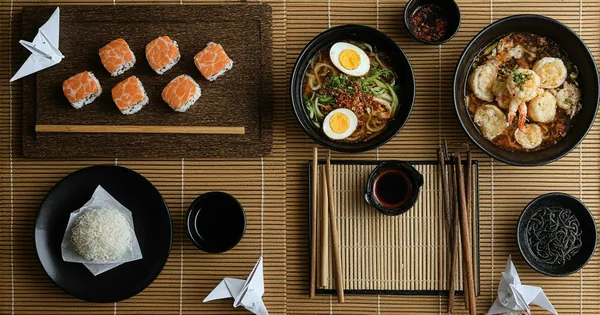
Japan
Experience Japan's exquisite culinary traditions from world-class sushi to comforting street food, with exceptional hygiene standards making it one of Asia's safest food destinations.
Discover East Asia's diverse culinary landscape, from Japan's meticulous sushi to China's regional specialties. Learn essential food safety tips for navigating seasonal changes while experiencing authentic cooking techniques.
In Japan's sushi restaurants, fresh fish should be properly refrigerated; in China and Korea, soups and stews should be served steaming hot at temperatures above 60°C/140°F
Clean preparation surfaces, organized kitchens, and proper food handling are hallmarks of safe establishments in Tokyo's Tsukiji Outer Market, Seoul's Gwangjang Market, and Taipei's night markets
Quality vendors across East Asia display fresh ingredients prominently; look for clear eyes on fish in Japanese markets, vibrant vegetables in Korean banchan, and fresh meat in Chinese hot pot restaurants
Busy stalls with local customers, especially businesspeople and families, indicate reliable quality in places like Hong Kong's dai pai dongs, Taiwan's night markets, and Japan's yokocho alleys
East Asian food vendors often specialize in one dish they've perfected over decades - a ramen shop in Tokyo, jianbing stand in Beijing, or gimbap stall in Seoul focusing on a single item suggests expertise and quality
Japan, Korea, Taiwan, and Hong Kong have robust food safety certification systems - look for displayed licenses, health department ratings, or QR codes linking to inspection records
Japan has exacting standards for raw fish preparation, while in China and Korea, raw dishes are less common - adjust expectations accordingly and be more cautious with raw foods outside of Japan
In high-altitude regions like Tibet and parts of Sichuan, water boils at lower temperatures, potentially affecting food safety - stick to thoroughly cooked foods and bottled water
Coastal cities like Tokyo, Shanghai, and Busan have fresher seafood than inland cities like Seoul, Xi'an, or Chengdu, where preserved preparations are traditional for safety reasons
East Asian cuisine is defined by its remarkable attention to detail, seasonal awareness, and balance of flavors, textures, and nutritional elements. Each country has distinct culinary traditions: Japan emphasizes minimalism, fresh ingredients, and umami; China showcases diverse regional styles from spicy Sichuan to delicate Cantonese; Korea balances bold flavors with nutritional harmony through fermentation; and Taiwan blends Chinese techniques with Japanese influences and local ingredients. Street food culture varies significantly - from Japan's organized yokocho alleys and department store food halls, to Taiwan's vibrant night markets, Korea's pojangmacha tents, and China's diverse regional street food scenes.
Explore Europe's diverse culinary landscape, from Italian trattorias to Spanish tapas bars and French bistros. Discover essential safety practices while navigating seasonal markets, street food festivals, and authentic regional specialties across this gastronomic paradise.
Discover Latin America and the Caribbean's vibrant culinary landscape, from Mexico's spicy street tacos to Brazil's churrasco and Caribbean seafood delicacies. Navigate distinctive regional preparation methods while ensuring safety across diverse climates and bustling mercados.
Discover Oceania's diverse culinary landscape, from Australia's modern fusion to traditional Polynesian earth ovens. Learn essential food safety tips for navigating tropical conditions while experiencing authentic Pacific Island cooking techniques and fresh seafood.
Navigate Southeast Asia's vibrant street food scene, from Thailand's aromatic curries to Vietnam's fresh herbs and Malaysia's spice blends. Discover essential safety practices for enjoying authentic flavors while managing tropical climate challenges.
Discover South Asia's vibrant culinary landscape, from India's aromatic curries to Nepal's hearty dumplings. Learn essential food safety tips for navigating diverse street food scenes while experiencing authentic flavors in Delhi, Mumbai, Kathmandu, and Colombo.